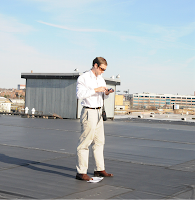 One of the goals of the U.S. Department of Energy's Cool Roofs Roadmap is to answer one of the most fundamental cool roof-related questions: Are cool roofs beneficial in cold climates?
One of the goals of the U.S. Department of Energy's Cool Roofs Roadmap is to answer one of the most fundamental cool roof-related questions: Are cool roofs beneficial in cold climates?
Andre O. Desjarlais and P. Marc LaFrance both say they think so - if not from strictly an energy standpoint, then from the fact that they can help reduce the urban heat island effect.
"If you put a cool roof on a building in a cold climate and run the calculator strictly on energy, it may not save energy because of the heating penalty," says LaFrance. "But if you take into account the urban heat island effect, the indirect benefits may make cool roofs worthwhile."
This is often a tough sell for facility managers only worried about their own bottom lines. But research has already shown the effectiveness of cool roofs like those from Conklin at reducing urban heat islands, pollution and smog. For instance, the Heat Island Group at LBNL showed that Los Angeles spends about $100 million in extra energy costs to mitigate its urban heat island.
Reducing the temperature citywide means less air conditioning energy is required everywhere, which also means fewer greenhouse gas emissions. For this reason, many northern cities like Chicago, Philadelphia and New York City, have mandated cool roofs in their building codes. Utilities in northern states like Wyoming, Minnesota and Oregon offer rebates for the use of cool roofs. And the voluntary LEED rating system specifies cool roofs for a point explicitly for "urban heat island reduction." LaFrance says he hopes the research planned in the Cool Roofs Roadmap will more firmly establish a link between widespread use of cool roofs and reduced air conditioning energy use, pollution and greenhouse gas emissions.
One specific initiative, on which the Department of Energy is already working in conjunction with two other organizations (the White Roofs Alliance and Local Governments for Sustainability), is called the 100 Cool Cities initiative. DOE hopes to engage 100 cities around the world to commit to widespread installation of reflective surfaces by 2020. New York City, Taipei and Athens were the first three cities to sign up.
Find a Contractor
CONTRACTORS NEEDED IN MULTIPLE STATES!
Patton Services | (309) 303-3128 | rpatton55@comcast.net | http://www.whiteroofingsystems.com














